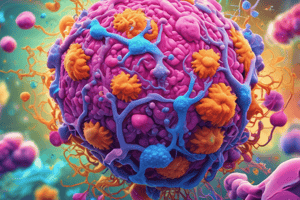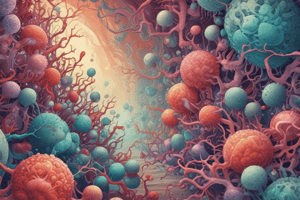Podcast
Questions and Answers
Which type of response is specific to the virus?
Which type of response is specific to the virus?
- Natural barriers response
- Adaptive response (correct)
- Innate response
- Acquired immunity response
What is the term for the release of infectious virus from an infected host?
What is the term for the release of infectious virus from an infected host?
- Viral spreading
- Viral diffusion
- Viral dissemination
- Viral shedding (correct)
What type of transmission is most common for viruses?
What type of transmission is most common for viruses?
- Vector-borne transmission
- Airborne transmission
- Horizontal transmission (correct)
- Direct transmission
What outcome of viral infection involves the presence of viral genome with no active replication?
What outcome of viral infection involves the presence of viral genome with no active replication?
Which method primes the adaptive immune system to prevent viral infections?
Which method primes the adaptive immune system to prevent viral infections?
Which type of vaccine uses live attenuated viruses?
Which type of vaccine uses live attenuated viruses?
'Selective toxicity' in antiviral agents refers to their ability to:
'Selective toxicity' in antiviral agents refers to their ability to:
What is the primary characteristic of viruses?
What is the primary characteristic of viruses?
What is the structure of a virion?
What is the structure of a virion?
Which Baltimore class includes HIV?
Which Baltimore class includes HIV?
What is the primary function of viral capsid?
What is the primary function of viral capsid?
How many structural units (capsomeres) typically make up a viral capsid with icosahedral symmetry?
How many structural units (capsomeres) typically make up a viral capsid with icosahedral symmetry?
Which type of nucleic acid does Hepatitis B virus contain?
Which type of nucleic acid does Hepatitis B virus contain?
What is the host range of viruses?
What is the host range of viruses?
What is the characteristic feature of retroviruses?
What is the characteristic feature of retroviruses?
Which step in viral pathogenesis involves the release of the virus through cell lysis or budding?
Which step in viral pathogenesis involves the release of the virus through cell lysis or budding?
What determines the severity of viral disease?
What determines the severity of viral disease?
Which type of transmission is associated with viral entry through ingestion of contaminated food and water?
Which type of transmission is associated with viral entry through ingestion of contaminated food and water?
Which virus is primarily localized in the upper respiratory tract during its primary replication?
Which virus is primarily localized in the upper respiratory tract during its primary replication?
What is the term for the presence of virus in the blood after spread and further replication, at a higher concentration?
What is the term for the presence of virus in the blood after spread and further replication, at a higher concentration?
What are the mechanisms for spread of viruses throughout the host?
What are the mechanisms for spread of viruses throughout the host?
What factors contribute to the selectivity of productive infection (tropism) of viruses in certain tissues?
What factors contribute to the selectivity of productive infection (tropism) of viruses in certain tissues?
What determines whether a viral infection remains local or becomes systemic during primary replication?
What determines whether a viral infection remains local or becomes systemic during primary replication?
Flashcards are hidden until you start studying



